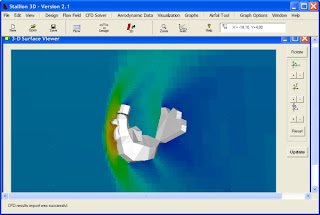Using a computer program to analyze the cross section (airfoil) of a wing, keel, sail combination or race car spoiler gives the design engineer valuable insight into the behavior and efficiency of the device. Furthermore, airfoil analysis provides a cost effective and quick first step in the conceptual design of the product. However, using conventional airfoil analysis tools (often based on panel methods) cannot handle a number of "difficult" shapes that are of interest to the modern design engineer. For example, panel methods have difficulty with truncated or blunt airfoils, airfoils with gurney flaps or wicker bills (often used on high end race cars), ground effect, thin airfoils (for modeling yacht sails) and airfoils at high angles of attack (for modeling wind energy devices).

Computational fluid dynamics (CFD) based on the Euler or Navier-Stokes equations provides solutions where panel methods fail. However, even in two-dimensions, general CFD methods can prove to be costly and time-consuming due to the grid generation process for complex geometries.
MultiElement Airfoils 5.0 provides a unique solution based on Euler/Navier-Stokes equations and automatic Cartesian grid generation method. The software is a turn-key approach to airfoils analysis (with a library of built-in airfoils and the ability to read-in DXF shapes) where solving a challenging system of multiple cross sectional shapes is as easy as analysing a single conventional airfoil.
an automatic Cartesian grid method.
A user can enter the shape from the library of airfoils, a custom shape from a file containing the airfoil ordinates or a .dxf file. In this case, a blunt airfoil shape is shown in the picture below.
Blunt airfoil geometry in MultiElement Airfoils.
The analysis starts by automatically generating a Cartesian grid using the program's menu system.
Automatic Cartesian grid adapts to the emersed boundary.
Next, the user can choose either an Euler equations solution or Navier-Stokes solution. The picture below shows the Euler equations solution coupled with a boundary layer solver. The program displays pressure, velocity ratio (seen below), Mach number, Temperature and density.
Flow velocity ratio with streamlines.
Airfoils with Gurney flaps (wicker bills) used in the racing industry can also be easily and accurately analyzed with MultiElement Airfoils 5.0.
The Navier-Stokes solution is chosen for this analysis (the Euler solution was also obtained for comparison). The pressure field is shown in the below picture.
Gurney flap solution showing pressure and streamlines.
The following picture shows the flow close to the gurney flap. It features a double separation region downstream of the flap. On the left side of the screen, a comparison is made between the surface pressure coefficient of the main airfoil and the flap computed using the Euler equations and the Navier-Stokes equations methods.
Streamlines near the trailing edge as computed in MultiElement Airfoils
Another application of MultiElement Airfoils is in analyzing thin airfoil shapes. This is useful for the design and analysis of the propulsion system for high performance yachts and sailboats. The picture below shows a model of the jib, mast and main sail as modeled in the software.
MultiElement Airfoils is ideal for computing the most optimal angles for the sail components.
Flow velocity and streamlines.
The picture below shows the mast and main sail components. The solution suggests that the sails are not at the best angles.
Flow velocity and streamlines near the mast and main sail.
In conclusion, MultiElement Airfoils 5.0 is a modern tool for the efficient and accurate evaluation of difficult airfoil cross sections. More information about the program can be found at
http://www.hanleyinnovations.com/mefoil.html



















